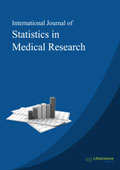ijsmr
Abstract : Modified Kaplan-Meier Estimator Based on Competing Risks for Heavy Censoring Data
|
|
Abstract: Most follow-up studies are conducted to determine the survival rates of subjects affected by a specific risk. These subjects are also exposed to other risks. Every subject in a medical follow-up is exposed not only to the risk of dying, but also to the risk of being censored. In case of heavy censoring, the Kaplan-Meier estimates are biased and overestimate the survival distribution. A new methodology based on competing risks is proposed to estimate the survival function by using net and crude probabilities. These estimates reduce the bias and overestimation of the survival distribution noted in Kaplan-Meier estimators. In this study, the method of modified Kaplan-Meier (MKM) is compared with the Kaplan-Meier (KM), Huang’s method and also the two other methods namely Weighted Kaplan-Meier (WKM) and Modified Weighted Kaplan-Meier (MWKM). Either of the weighted methods depends heavily on the event times and censoring distributions. Due to this fact, the weighted methods can have misleading results when the censoring patterns are different in the individual samples. The results showed that the MKM estimator considers not only the problem of heavy censoring but also the problem of weighted methods and competing risks in complicated data. In this study “Stanford Heart Transplant Data” was used to investigate the effectiveness of the proposed methods. Keywords: Competing risks, Kaplan-Meier estimator, Heavy Censoring, Net and Crude probabilities.Download Full Article |
Abstract : Longitudinal Data Analysis of Symptom Score Trajectories Using Linear Mixed Models in a Clinical Trial
|
|
Abstract: In clinical trials, longitudinal data are often analyzed using T-tests, anovas or ancovas instead of the more powerful linear mixed models. The purpose of this paper is to demonstrate how the more sophisticated linear mixed models according to the approach of Singer and Willett, which allows special insight into the behaviour of the data, can be used in clinical trials. Individual trajectories of PANNS-MNS Scores from a controlled clinical trial were used to demonstrate all the steps needed for an analysis of longitudinal data. The model is built step by step, model assumptions are checked, time-variant and time-invariant factors are included and the results are interpreted. The unique needs of a clinical trial, such as the calculation of effect sizes or of an appropriate sample size, are taken into account. Finally, a flow chart is presented that would serve as an instruction tool for the analysis of longitudinal data in clinical trials. Keywords: longitudinal studies, randomized controlled trial, linear models, sample size.Download Full Article |
Abstract : A Comparative Economic Analysis of Immunization Programs for Pertussis and Measles: The Use of ARIMA Model to Study the Epidemiological Situation in England and Wales
|
|
Abstract:Objective: We evaluate pertussis and measles immunization strategies and compare the consequences in terms of health effects and economic costs. Methods: Based on epidemiological data for pertussis and measles in England and Wales from 1970 to 2012, we use ARIMA approach to model the relation between notification cases and vaccination coverage for each disease. We then perform an economic evaluation of vaccination programs at 95% and discuss the benefits for the society to achieve this level when compared with lower vaccination rates currently observed. The advantages for the society of increasing vaccination coverage up to 98% are considered respectively for pertussis and measles. Results: The programs at a 95% vaccination rate, which is able to significantly reduce the mortality and the morbidity due to pertussis and measles, are confirmed to be the best cost saving immunization strategy. The total social net benefits are systematically maximized when the programs are compared to strategies with lower vaccination coverage. The decision to exceed the herd immunity level and reach the rate at 98% is economically justified for measles, while for pertussis the programs at 98% are less cost effective than the programs at 95%. Conclusion: Additional efforts must be carried out to promote measles vaccination since immunization strategies at 95% and at higher rates are recommended on epidemiological and economic grounds. Keywords: Pertussis and measles immunization, cost analysis of vaccination program, epidemiology of pertussis and measles in England and Wales, ARIMA transfer function model.Download Full Article |
Abstract : Prediction of Childhood Asthma Using Conditional Probability and Discrete Event Simulation
|
|
Abstract: Asthma prevalence in children and adolescents in Spain is 10-17%. It is the most common chronic illness during childhood. Prevalence has been increasing over the last 40 years and there is considerable evidence that, among other factors, continued exposure to cigarette smoke results in asthma in children. No statistical or simulation model exist to forecast the evolution of childhood asthma in Europe. Such a model needs to incorporate the main risk factors that can be managed by medical authorities, such as tobacco (OR = 1.44), to establish how they affect the present generation of children. A simulation model using conditional probability and discrete event simulation for childhood asthma was developed and validated by simulating realistic scenario. The parameters used for the model (input data) were those found in the bibliography, especially those related to the incidence of smoking in Spain. We also used data from a panel of experts from the Hospital del Mar (Barcelona) related to actual evolution and asthma phenotypes. The results obtained from the simulation established a threshold of a 15-20% smoking population for a reduction in the prevalence of asthma. This is still far from the current level in Spain, where 24% of people smoke. We conclude that more effort must be made to combat smoking and other childhood asthma risk factors, in order to significantly reduce the number of cases. Once completed, this simulation methodology can realistically be used to forecast the evolution of childhood asthma as a function of variation in different risk factors. Keywords: Children, Asthma, Model, Discrete event, Probability, Tobacco.Download Full Article |























